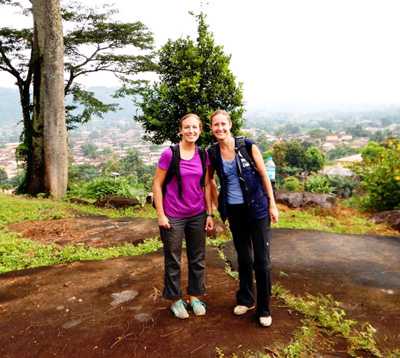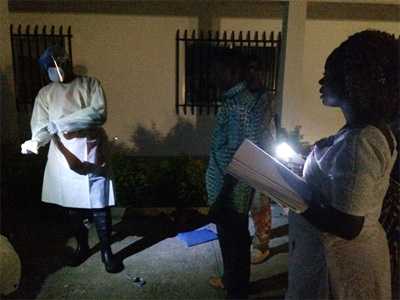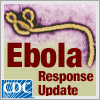CDC Responds to the 2014 Ebola Outbreak: Heidi and Lindsey

Guinea infection control team members Heidi and Lindsey spent five weeks conducting trainings for front line health care workers in N'Zerekore and Macenta (pictured).

The infection control training in Guinea didn’t stop when the sun went down. The students were so anxious to practice what they learned that they often stayed late into the evening using flashlights and the lights from their cell phones.
Before the Ebola outbreak in Guinea, infection control in local health clinics was minimal at best. When Ebola took hold, the fragile healthcare system contributed to the rapid spread of the virus and made it difficult to contain the epidemic.
“When thinking about infection control in Guinea it’s helpful to picture the average health facility in that country. It’s usually one to two rooms, it doesn’t have electricity or running water and it’s crowded with sick patients,” explains Heidi, a CDC scientist who recently spent five weeks in Guinea’s hardest hit areas.
Because of the dangers involved in treating sick patients during an Ebola epidemic – the early symptoms of Ebola are similar to those of many other illnesses — Heidi and fellow CDC scientist Lindsey implemented an infection-control training course for Guinean healthcare workers.
“Our infection control program trains frontline healthcare workers, everyone from doctors and nurses to janitors and ambulance drivers. The training included hands-on exercises in handwashing, triaging patients, putting on protective equipment and cleaning up contaminated fluids,” Lindsey says.
Their course was unique in that it focused on healthcare workers in facilities other than Ebola Treatment Units. “Workers in Ebola Treatment Units have already received a lot of training for handling Ebola cases. Healthcare workers in general hospitals and health clinics have not, yet their day-to-day work – delivering babies, vaccinating infants, treating malaria – can easily expose them to people with Ebola infections,” Heidi says. “These workers really need Ebola information and training so they can protect themselves and their patients.”
Heidi and Lindsey served as technical advisors for the training sponsor, Catholic Relief Services. Students were recruited from nearby health facilities, but on the first day of training people came from as far as 25 miles away!
“On the first day of the course we had 80 students enrolled, but over 100 more showed up eager to be trained and begging to have a spot in the course. Fortunately we were able to add more sessions to cover all healthcare workers in 3 priority regions of Guinea,” Lindsey says.
The classroom did not have electricity, so the course was scheduled to end before sunset. However, on many occasions students wanted to stay and practice longer. “The students were so anxious to learn that they would use flashlights or lights from their cell phones until they had all their questions answered,” Heidi says.
So far, more than 2,000 healthcare workers have been trained in Guinea. Similar programs are taking place in Liberia and Sierra Leone.
“More than 2,700 people have been infected with Ebola in Guinea. Around 150 of these are healthcare workers, more than half of whom have died. Even one healthcare worker infected with Ebola is too many,” Lindsey says.
The training course also certified infection control specialists who would oversee infection control in hospitals and clinics long-term.
“These efforts have the added benefit of being important not just in the context of an Ebola epidemic, but also because they are creating lasting improvements in infection control that should be there for the years to come,” Heidi says.
January 21, 2015 — CDC Ebola Response Update
 The latest numbers from CDC show more than 20,000 people in West Africa have been sick with Ebola, and more than 8,000 have died. As Dr. Tom Frieden explains, some areas may be starting to see a decrease in cases, but that does not mean the fight is over. CDC will continue its work in West Africa until we get to zero new cases.
The latest numbers from CDC show more than 20,000 people in West Africa have been sick with Ebola, and more than 8,000 have died. As Dr. Tom Frieden explains, some areas may be starting to see a decrease in cases, but that does not mean the fight is over. CDC will continue its work in West Africa until we get to zero new cases.
Created: 1/21/2015 by CDC’s Office of the Associate Director for Communication. Date Released: 1/21/2015. Series Name: CDC Ebola Response Update.
- Page last reviewed: January 8, 2014
- Page last updated: January 8, 2014
- Content source:


 ShareCompartir
ShareCompartir